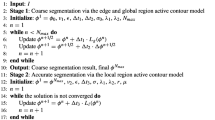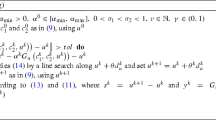Abstract
We analyze a variational approach to image segmentation that is based on a strictly convex non-quadratic cost functional. The smoothness term combines a standard first-order measure for image regions with a total-variation based measure for signal transitions. Accordingly, the costs associated with “discontinuities” are given by the length of level lines and local image contrast. For real images, this provides a reasonable approximation of the variational model of Mumford and Shah that has been suggested as a generic approach to image segmentation.
The global properties of the convex variational model are favorable to applications: Uniqueness of the solution, continuous dependence of the solution on both data and parameters, consistent and efficient numerical approximation of the solution with the FEM-method.
Various global and local properties of the convex variational model are analyzed and illustrated with numerical examples. Apart from the favorable global properties, the approach is shown to provide a sound mathematical model of a useful locally adaptive smoothing process. A comparison is carried out with results of a region-growing technique related to the Mumford-Shah model.
Similar content being viewed by others
References
J.-M. Morel and S. Solimini, Variational Methods in Image Segmentation, Birkhäuser: Boston, 1995.
D. Mumford and J. Shah, “Optimal approximations by piecewise smooth functions and associated variational problems,” Comm. Pure Appl. Math., Vol. 42, pp. 577–685, 1989.
S.R. Kulkarni, S.K. Mitter, T.J. Richardson, and J.N. Tsitsiklis, “Local versus nonlocal computation of length of digitized curves,” IEEE Trans. Patt. Anal. Mach. Intell., Vol. 16, No.7, pp. 711–718, 1994.
G. Koepfler, C. Lopez, and J. Morel, “A multiscale algorithm for image segmentation by variational method,” SIAM J. Numer. Anal., Vol. 31, No.1, pp. 282–299, 1994.
D. Geiger and A. Yuille, “A common framework for image segmentation,” Int. J. of Comp. Vision, Vol. 6, No.3, pp. 227–243, 1991.
S.Z. Li, Markov Random Field Modeling in Computer Vision, Springer-Verlag: Tokyo, 1995.
A. Blake and A. Zisserman, Visual Reconstruction, MIT Press, 1987.
D. Geiger and F. Girosi, “Parallel and deterministic algorithms from mrfs: Surface reconstruction and integration,” in First Europ. Conf. on Comp. Vision, O. Faugeras (Ed.), Springer Verlag, Lect. Notes. Comp. Sci., Antibes, Vol. 427, pp. 89–98, France, 1990.
C. Schnörr and R. Sprengel, “A nonlinear regularization approach to early vision,” Biol. Cybernetics, Vol. 72, pp. 141–149, 1994.
R.L. Stevenson, B.E. Schmitz, and E.J. Delp, “Discontinuity preserving regularization of inverse visual problems,” IEEE Trans. Systems, Man and Cyb., Vol. 24, No.3, pp. 455–469, 1994.
S.Z. Li, Y.H. Huang, and J. Fu, “Convex energy functionals in the da model,” in Proc. IEEE Int. Conf. Image Processing, 1995.
C. Schnörr, “Unique reconstruction of piecewise smooth images by minimizing strictly convex non-quadratic functionals,” J. of Math. Imag. Vision, Vol. 4, pp. 189–198, 1994.
C. Schnörr, “Segmentation of visual motion by minimizing convex non-quadratic functionals,” in 12th Int. Conf. on Pattern Recognition, Jerusalem, Israel, 1994.
C. Schnörr, R. Sprengel, and B. Neumann, “A variational approach to the design of early vision algorithms,” Computing Suppl., Vol. 11, pp. 149–165, 1996.
C. Schnörr, “Convex variational segmentation of multi-channel images,” in Proc. 12th Int. Conf. on Analysis and Optimization of Systems: Images, Wavelets and PDE's, Paris, Springer-Verlag, 1996.
W.P. Ziemer, Weakly Differentiable Functions, Springer: New York, 1989.
T. Poggio, V. Torre, and C. Koch, “Computational vision and regularization theory,” Nature, Vol. 317, pp. 314–319, 1985.
P.G. Ciarlet, The Finite Element Method for Elliptic Problems, North-Holland Publ. Comp.: Amsterdam, 1978.
D. Gilbarg and N.S. Trudinger, Elliptic Partial Differential Equations of Second Order, Springer-Verlag, 1983.
R. Sprengel, Entwurf und Analyse nichtlinearer Diffusionsverfahren für die Bildverarbeitung, Volume 123 of Dissertationen zur Künstlichen Intelligenz.infix, Sankt Augustin, 1996.
J.P. Aubin, Applied Functional Analysis, Wiley & Sons, 1979.
L.I. Rudin, S. Osher, and E. Fatemi, “Nonlinear total variation based noise removal algorithms,” Physica D, Vol. 60, pp. 259–268, 1992.
J.P. Aubin, Approximation of Elliptic Boundary-Value Problems, Wiley & Sons: New York, 1972.
V.A. Morozov, Methods for Solving Incorrectly Posed Problems, Springer-Verlag: New York, 1984.
J. Baumeister, Stable Solution of Inverse Problems, F. Vieweg & Sohn: Braunschweig/Wiesbaden, Germany, 1987.
E.M. Stein, Singular Integrals and Differentiability Properties of Functions, Princeton Univ. Press: Princeton, New Jersey, 1970.
R. Sprengel, C. Schnörr, and B. Neumann, “Detection of visual data transitions in nonlinear parameter space,” in Mustererkennung 1994, W.G. Kropatsch and H. Bischof (Ed.), Informatik Xpress: Technische Universität Wien, Vol. 5, pp. 315–323, 1994.
W. Förstner and E. Gülch, “A fast operator for detection and precise localization of distinct points, corners and circular features,” in Proc. Intercommission Conf. on Fast Processing of Photogrammetric Data, Interlaken, Switzerland 1987, pp. 281–305.
W. Förstner, “A framework for low level feature extraction,” in Computer Vision—ECCV’ 94, J.O. Eklundh (Ed.), Springer-Verlag, Lect. Notes. Comp. Sci., 1994, Vol. 801, pp. 61–70.
K. Rohr, “Recognizing corners by fitting parametric models,” Int. J. of Comp. Vision, Vol. 9, No.3, pp. 213–230, 1992.
T. Lindeberg, “Junction detection with automatic selection of detection scales and localization scales,” in Proc. 1st Int. Conf. Imag. Proc., Austin Texas, 1994, pp. 924–928.
K. Michalski, “Implementation und analyse eines ansatzes zur bildsegmentation nach mumford und shah,” Semesterwork, Universität Hamburg, AB KOGS, Mai 1996.
Y.G. Leclerc, “Constructing simple stable descriptions for image partitioning,” Int. J. of Comp. Vision, Vol. 3, No.1, pp. 73–102, 1989.
K. Deimling, Nonlinear Functional Analysis, Springer-Verlag: Berlin, 1985.
M.S. Berger, Nonlinearity Functional Analysis, Academic Press: New York, 1977.
Author information
Authors and Affiliations
Rights and permissions
About this article
Cite this article
Schnörr, C. A Study of a Convex Variational Diffusion Approach for Image Segmentation and Feature Extraction. Journal of Mathematical Imaging and Vision 8, 271–292 (1998). https://doi.org/10.1023/A:1008278718907
Issue Date:
DOI: https://doi.org/10.1023/A:1008278718907




